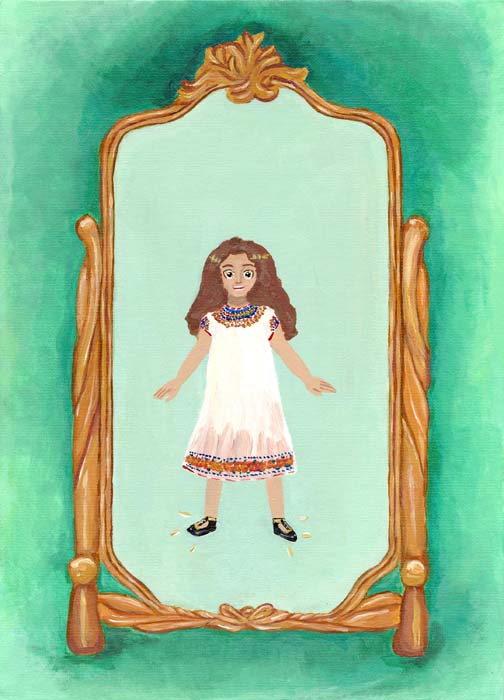Teresa, con amor Part 1: My First Pair Of Charoles
Illustrated by Lilly Le
I still remember my first pair of charoles. I wore them in the burning sweaty days of summer, the puddly days of spring, the windy days of autumn and the humidly cold days of winter. My mom bought them for me when I was eleven, to wear them to my cousin Esperanza’s quinceañera. She was not wearing charoles, but pearly-white heels that made her long dress look as if it floated around the room; that night I made a mental note of asking for pearly-white heels for my quinceañera.
 My charoles were extra shiny, the clasps golden and custom made. Nachita took me to the shoemaker, the one in between the hardware store “La Fragua” and the tianguis where I go with Nachita sometimes to buy vegetables and where, sometimes, I get to eat a chalupa while Nachita meets with her boyfriend Luisito. My mom doesn’t know that last part; she would fire Nachita if she found out: “What would people say if mi muchacha is seen whoring around?” she’d say. I sometimes threaten Nachita with telling my mom when she doesn’t let me do what I want, like eat dulce de papaya or tamales dulces, but I think she knows I don’t really mean it, I like her and I don’t want her gone.
My charoles were extra shiny, the clasps golden and custom made. Nachita took me to the shoemaker, the one in between the hardware store “La Fragua” and the tianguis where I go with Nachita sometimes to buy vegetables and where, sometimes, I get to eat a chalupa while Nachita meets with her boyfriend Luisito. My mom doesn’t know that last part; she would fire Nachita if she found out: “What would people say if mi muchacha is seen whoring around?” she’d say. I sometimes threaten Nachita with telling my mom when she doesn’t let me do what I want, like eat dulce de papaya or tamales dulces, but I think she knows I don’t really mean it, I like her and I don’t want her gone.
Don Miguel, the shoemaker, always smells like raw onions and looks very dirty, grease all over his face and arms, but he is a nice man. That day, he let me see how my charoles were made. Making a shoe is hard; you have to mold the leather and make it shiny with some strange, gooey, brown substance and then let it dry... it’s a whole process. The shop was even warmer than outside, which was saying something, because that summer in Merida had been one of the warmest. My huipil was made of thick, white cotton and embroidery that was brought by boat all the way from Europe, and I remember getting it all wet from sweat and filthy from shoe grease.
When my charoles were done, I demanded to wear them immediately. There was no mirror at the shoemaker’s, so I went running back to my house, followed by Nachita screaming “¡Las señoritas no corren Teresita!”. I quickly went through the big, white and pastel-colored, French-style houses and stopped at the biggest one of the block; I went in through the service entrance to avoid my mother’s scolding for ruining my dress and passed the kitchen staff without even saying hello. I went up three stairs without stopping and opened the heavy door to go into my mother’s closet.
It was a spacious room with an old, rococo-style boudoir, filled with the most expensive perfumes and make-up powders one could ever buy. I went directly to the big, full-body mirror at the back of the room, going through lines and lines of dresses, hats, sometimes stopping to look at the beautiful shoes my mommy had.
Finally, I put myself in front of the mirror and looked at myself. My long braid was now undone and baby hairs crowned my head and made a golden aureole. My cheeks were red from running and my pupils were dilated and shined. What once was a white dress was now brown from the dust of the streets and covered in grease marks.
But the shoes, the shoes were something else. They whispered encouraging words; they became my most reliable friends and my secret keepers. They accompanied me to many of my adventures; they witnessed my first fight, when the cook’s son, Pedrito, kicked me in the knee, and also my first kiss, a few minutes after, also with Pedrito.
They gave me strength and held me up whenever I was about to fall.

Comments
No comments posted yet.
You have to be registered and logged in in order to post comments!